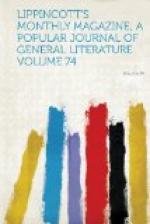The third part was Das Opfermahl—the offering of bread and wine by Melchisedek to Abraham, prefiguring the Last Supper. Prelude by orchestra. The curtain rises, displaying Melchisedek before an altar, on which are bread and wine. Four attendants are near him. He, in a flowing white robe, discourses to them. The scene is simple and natural. Enter Abraham and attendants on one side and Lot and attendants on the other, all dressed in Roman mantles, buskins and helmets. The stage was filled and the grouping admirable. Abraham and Lot discourse, embrace and part, Lot and his followers retiring. Melchisedek comes forward and addresses Abraham, who replies at some length. Then Melchisedek prepares his bread and wine, takes some, then offers to Abraham, who eats and drinks. Meantime, a most charming chorus of Handel is sung behind the scenes, while Melchisedek and his attendants offer the bread and wine to all of Abraham’s suite, who partake reverentially. Tableau and chorus, and the curtain descends. The ease and simple quiet action of all this scene were remarkable.
Enter Chorus as before: leader speaks. They divide and the curtain rises on the tableau of the Last Supper. I know not whether it was taken from any one picture—I think not—but it was simply and effectively grouped, and it recalled both Lionardo and Andrea del Sarto. This lasted two and a half minutes, during which time the contralto sang an air of Mozart’s.
The fourth part—Die Ergebung (Resignation)—was represented in the play by Abraham’s willingness to sacrifice his son at God’s command, prefiguring the agony of Christ in the Garden.
After a prelude by the orchestra the curtain rose and discovered Abraham and Isaac in loving discourse, with figures in the background, admirably costumed and grouped. An angel in white robe and blue mantle appears and delivers his heavenly message to the astounded Abraham. His agony was simply and feelingly depicted. He appears at last resigned, when Sarah, in red robe and Eastern headdress, enters to renew his grief. The beauty of this woman was of the highest order in feature and expression, and her dress was truly artistic. The scene between these two was most touchingly acted. Isaac reappears, thinking that he is simply going on a journey, and, scarcely comprehending his mother’s great grief, presents his companion to her as a comfort and stay, thus prefiguring John and Mary at the cross. Abraham and Isaac depart, and the curtain falls.
Then another prelude by the orchestra, and the Chorus appears: the leader delivers the epilogue. They divide and kneel, and the curtain rises on the tableau of the scene in Gethsemane.
Christ, on an elevation, is kneeling: an angel stands in front of him. Below, the apostles are all asleep in groups. Behind, in the centre, Judas advances with the soldiers, who bear tall lanterns. It was like a picture of Carpaccio, and worthy of that great master. This tableau lasted two and a quarter minutes, during which time the tenor sang an aria.




